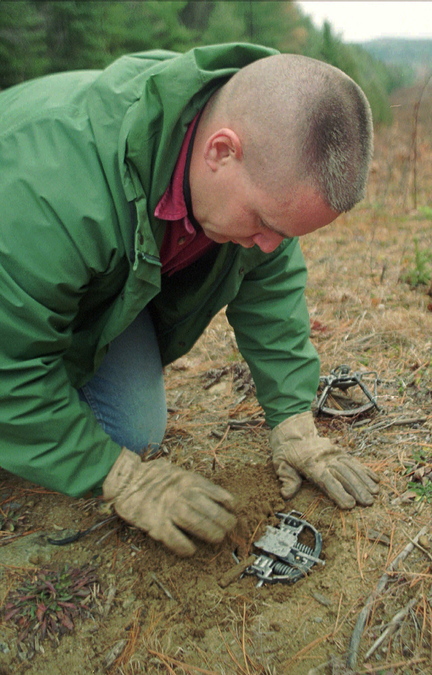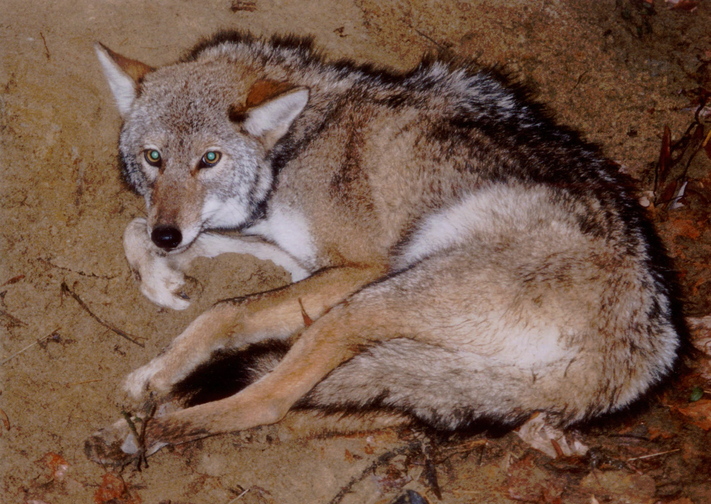Fur trapping is increasing in Maine as the value of pelts climbs, which may have contributed to two incidents in which dogs got caught in coyote traps.
The number of trapping licenses issued by the state climbed 21 percent in the past two years, from 2,236 in 2010 to 2,708 in 2012. The licenses cover trapping for fur-bearing species including beaver, fisher, bobcat and otter.
Prices for furs – including coyote – have increased an average of 70 percent over the same period.
Coyote trapping has drawn attention since an 84-year-old man shot his dog on Oct. 24 after it got caught in a coyote trap in Newfield and bit him when he tried to set it free. Alberto Carva said the frightened animal bit his hand and wouldn’t let go, so he had to shoot his favorite rabbit hunting dog.
Trapping advocates and state officials say that incident is an anomaly. More often, they say, the dog is released uninjured, as happened Sunday in Topsham.
Linn Caroleo was walking her silver Labrador retriever, Yogi, on the cleared right-of-way under transmission lines off Route 201 when his paw was grabbed by a coyote trap.
“It was pretty violent right at first,” she said. “He was trying to get loose, yanking on it, and I thought, ‘Oh, Jeez, he’s going to break a paw.’ But I put my arm around him and made him get closer so it was not so taut.”
Fortunately, she said, her dog didn’t bite her.
Caroleo tried to free her dog by pulling the jaws of the trap apart, but only managed to get her thumb stuck in it, she said. She called for help on her cellphone with her free hand.
Afterward, firefighters showed her how a trap is disarmed – by pulling down on release levers on either end of the semicircle formed by the closed jaws. Neither Caroleo nor the dog required medical attention, though Caroleo – who writes children’s books about her dogs and their misadventures – said she had her dog’s leg X-rayed to be sure.
The owner of the traps removed the half-dozen in that area of the transmission line. Police said he had set them the previous day.
MODERN TRAPS ARE TOOTHLESS
Modern traps for coyotes or foxes are designed to capture but not injure animals. They don’t have teeth on the jaws, which sometimes have padding or are made of hard rubber and leave a gap when they are closed.
“The traps you’re talking about, I’ve used those probably 40 years and had every one of my fingers caught in one of these traps,” said Bruce Martin of Biddeford, an experienced trapper who teaches courses on trapping. “I still have all my fingers.”
The state Department of Inland Fisheries and Wildlife uses the same type of traps for catching lynx, which are then tagged and released. The state does not track how often dogs or other species get caught in coyote traps.
Dogs get caught in coyote traps because the species are so similar. The traps must be well hidden but in places where coyotes might step, often along trails or the edges of fields – where people walk their dogs.
“When you put out coyote traps, you can’t put a sign saying ‘Coyotes only, step here,’ ” Martin said.
The traps can’t be marked because that may scare off their intended prey. And people have intentionally triggered traps or even taken them, trappers said.
MORE HOBBY THAN PAYCHECK
After a severe drop-off 20 years ago, trapping is rebounding as prices for pelts rise. The latest prices vary widely, from $112 for bobcats to $3 for weasels.
The price for coyote hides has risen from $15.44 in 2010, when 18 were sold at the auction held in March by the Central Maine Chapter of the Maine Trappers Association, to $24 in the December 2012 auction, when 61 were sold.
The price averaged $27 this March, and trappers speculate that overseas demand is driving the market. The value of a pelt varies by its size, the thickness of the fur and the care with which it is removed and prepared.
But trapping is more of a hobby than a way to make money. Trappers must take a 10-hour state course on responsible trapping. They must check their traps daily and have the permission of the owner of the land where they set traps, which must identify the owner.
Some trappers put out just four or five traps, while others in the state’s unorganized territories might put out 100, said Rick LaFlamme, a state game warden who has been trapping most of his life.
Once an animal is trapped, the trapper has to kill it, skin it and treat the hide, storing it until an auction in the spring or winter.
After calculating the initial investment in traps – which can cost about $10 to $15 each – and related equipment plus the time it takes to check traps, then process the hide, “Per hour, they’re making 25 cents,” LaFlamme said.
LaFlamme said trappers can be secretive because skill is acquired through years of study and experience.
“You’re trying to get an animal stepping in this one inch-and-a-half spot,” as opposed to sitting in a deer blind with a rifle, waiting for the animal to come within range.
POPULATION CONTROL TOOL
Maine’s statewide season for trapping species including coyotes runs from Nov. 3 to Dec. 31. An early fox and coyote trapping season runs from Oct. 20 to Nov. 2, according to the Department of Inland Fisheries and Wildlife.
That early season is intended to give trappers a chance before hunting season and before the ground freezes, when trapping can be more challenging.
Any other species that end up in the traps during the early season must be released.
Trappers and wardens often carry catch poles with snares, which can be used to hold an animal’s jaws away when releasing a trap. Some trappers also use a piece of plywood with a portion cut away so they can protect themselves from the animal while releasing the trap’s jaws, LaFlamme said.
When those tools aren’t available and a dog is trapped, someone could call the Maine Warden Service or toss their coat over the animal to keep it from biting while the trap is released, LaFlamme said.
“The dog is whining because it’s scared,” he said. “It doesn’t know you’re trying to help it. They think you’re inflicting the pain on it.”
LaFlamme said he gets calls from angry dog owners whose animals have gotten caught in traps, though the trapper typically has an established relationship with the landowner and the dog owner has not sought permission to walk there.
“These traps are on trails where coyotes and foxes travel. They like path of least resistance,” he said. So do people, who walk on trails or at the edge of a field.
Trapping is an important part of wildlife management, said Martin, the trapper from Biddeford. Nothing preys on coyotes or fishers, so the food supply is the only other limit on their population.
When populations get too dense, diseases like mange and rabies can spread and competition for food can push them into conflicts with people.
David Hench can be contacted at 791-6327 or at:
dhench@pressherald.com
Send questions/comments to the editors.




Success. Please wait for the page to reload. If the page does not reload within 5 seconds, please refresh the page.
Enter your email and password to access comments.
Hi, to comment on stories you must . This profile is in addition to your subscription and website login.
Already have a commenting profile? .
Invalid username/password.
Please check your email to confirm and complete your registration.
Only subscribers are eligible to post comments. Please subscribe or login first for digital access. Here’s why.
Use the form below to reset your password. When you've submitted your account email, we will send an email with a reset code.